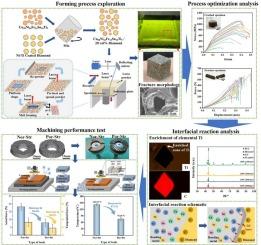Additive manufacturing of structured grinding wheels with a composite of Cu38Ni34Fe13Sn10Ti5 high-entropy alloy and Ni/Ti dual-coated diamonds: Interfacial characteristics, mechanical properties and grinding performance
IF 4.6
2区 材料科学
Q2 MATERIALS SCIENCE, MULTIDISCIPLINARY
International Journal of Refractory Metals & Hard Materials
Pub Date : 2025-07-30
DOI:10.1016/j.ijrmhm.2025.107360
引用次数: 0
Abstract
The use of Laser Powder Bed Fusion (LPBF) for additive manufacturing of metal-bonded diamond composites is emerging as a significant and challenging issue, particularly in the fabrication of structured abrasive wheels suitable for precision machining in aerospace, defense, and military industries. In this work, the LPBF process parameters for a new composite of Cu38Ni34Fe13Sn10Ti5 high-entropy alloy and Ni/Ti dual-coated diamonds were optimized based on mechanical performance and interfacial reaction considerations, and fabricated structured abrasive wheels for performance evaluation. Results indicated that the parameter combination of 120 W laser power, 1600 mm/s scan speed, 100 μm hatch spacing, and 30 μm layer thickness achieved superior forming quality and high mechanical strength. The formation of TiC interfacial reaction layers between diamond and the metal matrix was experimentally confirmed. Friction wear test demonstrated the composites' excellent self-sharpening capability, which is critical for diamond tools. Normal and porous structure (named Nor-Str and Por-Str) abrasive wheels were successfully fabricated, with Por-Str exhibiting significantly lower grinding forces and thermal accumulation. These findings establish a technical foundation for the additive manufacturing of diamond-metal composites and the efficient fabrication of functional abrasive tools.

Cu38Ni34Fe13Sn10Ti5高熵合金与Ni/Ti双涂层金刚石复合结构砂轮的增材制造:界面特性、力学性能和磨削性能
激光粉末床融合(LPBF)用于金属结合金刚石复合材料的增材制造是一个重要而具有挑战性的问题,特别是在制造适用于航空航天、国防和军事工业精密加工的结构化砂轮方面。基于力学性能和界面反应的考虑,优化了Cu38Ni34Fe13Sn10Ti5高熵合金与Ni/Ti双涂层金刚石复合材料的LPBF工艺参数,并制作了结构砂轮进行性能评价。结果表明:120 W激光功率、1600 mm/s扫描速度、100 μm舱口间距、30 μm层厚等参数组合可获得较好的成形质量和较高的机械强度。实验证实了金刚石与金属基体之间TiC界面反应层的形成。摩擦磨损试验表明,复合材料具有优异的自锐性,这对金刚石工具至关重要。成功制备了普通和多孔结构(Nor-Str和Por-Str)砂轮,其中Por-Str的磨削力和热积累明显降低。这些发现为金刚石-金属复合材料的增材制造和功能磨具的高效制造奠定了技术基础。
本文章由计算机程序翻译,如有差异,请以英文原文为准。
求助全文
约1分钟内获得全文
求助全文
来源期刊
CiteScore
7.00
自引率
13.90%
发文量
236
审稿时长
35 days
期刊介绍:
The International Journal of Refractory Metals and Hard Materials (IJRMHM) publishes original research articles concerned with all aspects of refractory metals and hard materials. Refractory metals are defined as metals with melting points higher than 1800 °C. These are tungsten, molybdenum, chromium, tantalum, niobium, hafnium, and rhenium, as well as many compounds and alloys based thereupon. Hard materials that are included in the scope of this journal are defined as materials with hardness values higher than 1000 kg/mm2, primarily intended for applications as manufacturing tools or wear resistant components in mechanical systems. Thus they encompass carbides, nitrides and borides of metals, and related compounds. A special focus of this journal is put on the family of hardmetals, which is also known as cemented tungsten carbide, and cermets which are based on titanium carbide and carbonitrides with or without a metal binder. Ceramics and superhard materials including diamond and cubic boron nitride may also be accepted provided the subject material is presented as hard materials as defined above.

 求助内容:
求助内容: 应助结果提醒方式:
应助结果提醒方式:


